Samuel L. Jackson The Hateful Eight
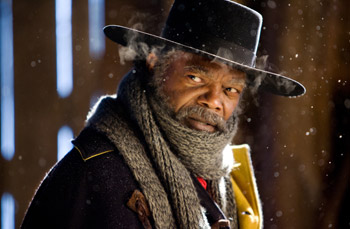
Samuel L. Jackson The Hateful Eight
Cast: Channing Tatum, Samuel L. Jackson, Kurt Russell
Director: Quentin Tarantino
Genre: Western
Running Time: 168 minutes
Synopsis: In The Hateful Eight, set six or eight or twelve years after the Civil War, a stagecoach hurtles through the wintry Wyoming landscape. The passengers, bounty hunter John Ruth (Kurt Russell) and his fugitive Daisy Domergue (Jennifer Jason Leigh), race towards the town of Red Rock where Ruth, known in these parts as 'The Hangman," will bring Domergue to justice. Along the road, they encounter two strangers: Major Marquis Warren (Samuel L. Jackson), a black former union soldier turned infamous bounty hunter, and Chris Mannix (Walton Goggins), a southern renegade who claims to be the town's new Sheriff. Losing their lead on the blizzard, Ruth, Domergue, Warren and Mannix seek refuge at Minnie's Haberdashery, a stagecoach stopover on a mountain pass. When they arrive at Minnie's, they are greeted not by the proprietor but by four unfamiliar faces. Bob (Demian Bichir), who's taking care of Minnie's while she's visiting her mother, is holed up with Oswaldo Mobray (Tim Roth), the hangman of Red Rock, cow-puncher Joe Gage (Michael Madsen), and Confederate General Sanford Smithers (Bruce Dern). As the storm overtakes the mountainside stopover, our eight travelers come to learn they may not make it to Red Rock after all…
The Hateful Eight
Release Date: January 21st, 2016
About the Production
The Hateful Eight made its auspicious debut on April 19, 2014 as a staged reading benefitting Film Independent, a non-profit organization that champions the independent filmmaker. Downtown Los Angeles's Ace Hotel Theatre, a former movie palace, swelled to its 1600-seat capacity as fans of Quentin Tarantino assembled for an unprecedented live performance of the writer-director's latest work.
Tarantino performed his screenplay's action and description lines alongside an award-winning ensemble of Tarantino 'regulars," including Samuel L. Jackson, Kurt Russell, Walton Goggins, Tim Roth, Michael Madsen, Bruce Dern, James Parks, Dana Gourrier and Zoë Bell.
Kurt Russell was not informed of the scale of the reading when he signed on to play John 'The Hangman" Ruth. During the three-day rehearsal process, the actor heard rumblings from his fellow cast about a 'theater." Kurt Russell remembers: 'I said, -Wait a minute. What are you talking about?'"
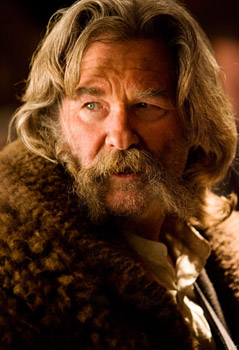 'And then I found out we were going to be doing this at a theater with sixteen hundred seats for charity. I thought, -OK, this is good,'" Kurt Russell muses. 'It was kind of special. There was a lot of energy in the theater. People were excited to hear it." 'I have terrible stage fright," Tim Roth recalls. 'It was a mixture of film and theater, the reading. It was extraordinary fun. I was exhausted by the end of it. Everyone was revved up, and excited, and nervous. Quentin made a show out of it, and it was a hot ticket."
'And then I found out we were going to be doing this at a theater with sixteen hundred seats for charity. I thought, -OK, this is good,'" Kurt Russell muses. 'It was kind of special. There was a lot of energy in the theater. People were excited to hear it." 'I have terrible stage fright," Tim Roth recalls. 'It was a mixture of film and theater, the reading. It was extraordinary fun. I was exhausted by the end of it. Everyone was revved up, and excited, and nervous. Quentin made a show out of it, and it was a hot ticket."
'The audience went crazy for it," Walton Goggins, who plays Chris Mannix, recalls, adding that there was a shared pride among the actors following the reading: 'In that moment, we all looked at each other, and we all felt the same way: whether this gets made or not is irrelevant. We were here for this once in a lifetime experience, and if it were to get made, then that would be the icing on the cake."
Although Tarantino intended for the reading to be a standalone event, the overwhelming response inspired the director to reconsider immortalizing The Hateful Eight on film. 'People gave us a standing ovation after the reading, which was amazing," Samuel L. Jackson, who plays Major Marquis Warren, recalls. 'We all looked at each other, thinking, -how's he not going to make this movie after that?" Roughly eight months later, principal photography on The Hateful Eight began in Telluride, Colorado.
As the production moved forward, Tarantino re-teamed with producers Richard N. Gladstein (executive producer of Reservoir Dogs, Pulp Fiction and Jackie Brown), Stacey Sher (executive producer of Pulp Fiction and producer of Django Unchained) and Shannon McIntosh (executive producer of DJANGO UNCHAINED and DEATH PROOF).
Gladstein responded to the universality of the story, and to its characters' distinct, unpredictable allegiances. 'In all of Quentin's movies there is heightened human interaction, and heightened human drama," Gladstein says. The Hateful Eight throws characters together and tests their loyalties, and the principles their loyalties belong to."
'The Hateful Eight is an extraordinary microscope onto the human condition, and the ways that we identify ourselves, and the way we travel through life, and what extreme circumstances do to people, and the shifting nature of loyalty and betrayal," Sher says. 'This is all placed in a package of a really fun, funny, winter western that's very authentic and revealing about human nature."
Anyone in attendance at the staged reading would have heard Tarantino remark -- more than once -- that The Hateful Eight would be filmed 'in glorious 70mm." Tarantino went one step further: he chose
to film in a stunning, long-dormant format called Ultra Panavision 70. Last used in 1966 on Khartoum, Ultra Panavision 70 employs anamorphic lenses (as opposed to traditional spherical lenses) to create a 'gloriously" wide aspect ratio of 2.76:1. Ultra Panavision 70 was used on only a handful of films, including MUTINY ON THE BOUNTY, IT'S A MAD, MAD, MAD, MAD WORLD, THE GREATEST STORY EVER TOLD, and BATTLE OF THE BULGE.
'Capturing this bleak Western landscape, capturing the snow, capturing the beauty of these locations would be perfect for 70mm," Tarantino says, noting that the format also brings intensity to the film's interiors. 'I believe that these big formats offer more intimacy. You can be closer to the characters. It could bring you closer and invade the intimacy of the characters in its bigness. I don't think that it is a format that is only meant for travelogues."
McIntosh agrees that the immersive widescreen experience enriches the mystery once the Eight converge inside of Minnie's Haberdashery. 'There is so much going on in the frame with these characters that every time you watch a shot you see something different. You pick up a nuance of the character, you pick up an expression of one of these -- as we call them, haters -- and it's just magnificent. I can't imagine shooting it in any other way."
'You have eight characters, so in the room, you can fill the frame continually with all of your characters," Richardson says. 'An audience can monitor virtually every shot, where a character is. The width of this frame gives you a claustrophobic feel, since you can see all of the walls. It closes you in, and the experience of the acting is multiplied, in my opinion."
The width of the projected image is only part of what makes Ultra Panavision 70 a preferred format. Film captures depth, color and light in ways that the digital image cannot: 'Oftentimes with the new digital world people say it's so clear," producer Shannon McIntosh notes. 'We're clear and in a way that is so beautiful because of this film. It is hard to imagine folks wanting to go back to look at a digital image after that. It's spectacular."
'When people see The Hateful Eight, they won't ask, -Why did you bother shooting it on 70,'" Tarantino says. 'How gorgeous it is, and how intimate it is, and how vivid it is, and how intimate it is will be the answer."
As glorious as shooting in Ultra Panavision 70 was for the cast and crew, the emergence of digital filmmaking almost pushed traditional filmmaking into obsolescence. Last year, Tarantino banded together with several studios and filmmakers Christopher Nolan and J.J. Abrams in their support of Kodak, allowing the company to continue to produce film stock. In turn, Kodak's support was integral in making The Hateful Eight a reality.
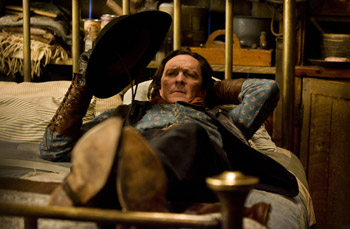 Breaking new and old ground was no small feat. Once Tarantino and director of photography Robert Richardson chose to move forward with Ultra Panavision 70, Panavision's Bob Harvey, Jim Raudebush and Dan Sasaki gathered and refurbished equipment that is a part of film history. Panavision pulled fifteen lenses from storage and displays, including lenses used on the chariot sequence in Ben Hur, and reconstructed them for use with contemporary cameras.
Breaking new and old ground was no small feat. Once Tarantino and director of photography Robert Richardson chose to move forward with Ultra Panavision 70, Panavision's Bob Harvey, Jim Raudebush and Dan Sasaki gathered and refurbished equipment that is a part of film history. Panavision pulled fifteen lenses from storage and displays, including lenses used on the chariot sequence in Ben Hur, and reconstructed them for use with contemporary cameras.
The decision to use Ultra Panavision came about when Richardson and Tavenner conducted tests at Panavision's headquarters, when Richardson stumbled upon an archive of Ultra Panavision lenses. Richardson asked Panavision's Dan Sasaki if there was any way to update the lenses for modern cameras.
Knowing that the lenses would meet with extreme conditions, Sasaki, Richardson and first assistant camera Gregor Tavenner conducted a series of tests to make certain that the lenses could endure the cold weather and humidity. 'For the most part, it was incredible that you could take these lenses out there, and they worked almost perfectly. It was like uncorking a really expensive red wine from the 50s," Tavenner says.
The antique lenses exceeded expectations and reminded the cast and crew of the richness that the process brought to the epic widescreen masterpieces of the 1960s. 'It's such a pleasure to actually be shooting with a format that does justice to outdoor photography. Finally, you have a camera system that can record detail in its full glory. It opens up so much more information on film. It's really beautiful, and it brings you back to some of that awe that we all experienced when we were kids watching the big picture projected in a cinema," Tavenner says.
Panavision further facilitated the production by creating two-thousand-foot mags, which allowed for complete scenes to play out before the camera rolled out of film. (The industry standard for 65mm is a five-hundred-foot mag.) Two-thousand-foot mags were invented specifically for The Hateful Eight. 'I didn't want to have to shoot in short little bits. I've got a lot of big actor takes, and I wanted to run the scenes from beginning to end. I could run long acting takes and have a take have integrity from the beginning until the end, because I do a lot of five and six and seven minute scenes. Panavision was a hundred percent on board for what it is we were trying to do. It was really lovely because they didn't look at it as just another movie, they looked at it as a legacy movie," Tarantino says.
In keeping with Tarantino's appreciation for film and a bygone era of distribution, The Hateful Eight will be released domestically on December 25, 2015 exclusively in theaters equipped to project 70mm film. The movie palace experience will live again in one hundred theaters with an exclusive roadshow in the largest 70mm release in over twenty years.
'The thing about the roadshows that they used to do was that it made movies special. It wasn't just a movie playing at your local theater. Some of them were musicals, some were big historical epics. They would do these big productions before the normal release of the film. You would get a big colorful program. It was a big presentation. They would play a Broadway show overture version of the soundtrack. If you're going to shoot your movie and release it in 70mm, it's really the way to go," Tarantino says. 'Twenty-four frames a second flickering through a projector, creating the illusion of movement."
The roadshow experience features an exclusive overture composed by the legendary Ennio Morricone. Tarantino journeyed to Rome to meet with the composer after the film wrapped production last summer. Unfortunately for Tarantino, Morricone was busy with another project and could not commit to The Hateful Eight, although the composer noted that he was inspired to write a theme after reading the script. Disappointed but understanding, Tarantino continued his meeting with Morricone, though the conversation shifted to small talk. The next day, the tireless Morricone told Tarantino that he had written another piece for the film. Bit by bit, Morricone weaved together the tense, haunting score for The Hateful Eight.
Chosen for its unspoiled, stunning vistas, Telluride's stretch of the Colorado Rockies became home to Minnie's Haberdashery, the mountainside stopover where 'The Hateful Eight" converge. The Haberdashery was constructed on the Schmid Family Ranch on Wilson Mesa.
'Once we got there and you saw that mountain [Wilson peak], and you imagined where the haberdashery could be, there was no other place," McIntosh remembers. 'It's the mountains and vistas of the Telluride area that are so spectacular. The Aspen trees there, which really become another character within the movie, are amazing. You could not visualize finding that anywhere else. Telluride truly was a remarkable place to shoot the movie."
'For a rocky, brutal, unforgiving winter western you need a rugged, unforgiving, cold, wintery western terrain, and we looked everywhere" Sher remembers. 'The proximity of the Colorado Rockies doubling for Wyoming really gave you the feeling that these were going to be harsh times for these characters, and that there would be circumstances that were both magnificent, and awe-inspiring, and terrifying, and definitely unforgiving."
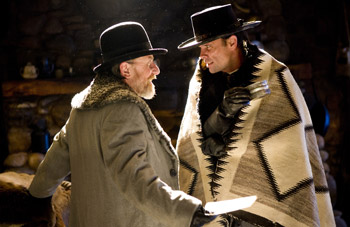 After settling on a location, Yohei Taneda, the production designer responsible for Kill Bill's 'House of Blue Leaves," designed Minnie's. Taneda, who is a fan of westerns, was happy to put his stamp on the genre. 'I was a big fan of western films because my father was a fan of western films," Taneda says. Shane is my favorite movie. The store is many things: a drug store, bar, and restaurant."
After settling on a location, Yohei Taneda, the production designer responsible for Kill Bill's 'House of Blue Leaves," designed Minnie's. Taneda, who is a fan of westerns, was happy to put his stamp on the genre. 'I was a big fan of western films because my father was a fan of western films," Taneda says. Shane is my favorite movie. The store is many things: a drug store, bar, and restaurant."
Indeed, 'haberdashery" is a bit of a misnomer: 'A haberdashery is a hat factory, more or less. I read the script and everything but a haberdashery is how it's described," art director Richard Johnson comments.
Indeed, even Tarantino's characters comment on the unlikely destination. 'Oh I get it, haberdashery, that was a joke," Walton Goggins's Chris Mannix comments upon surveying the eclectic space.
'Every corner of the haberdashery is layered, and textured, and the actors love it," Sher notes. 'You pull out a drawer and there are things inside. There's never anything on that set that doesn't feel absolutely real."
'After twelve weeks of shooting, you could walk around the set and discover new little things on the shelves, and these crazy bottles, or rifle cartridges, or food ingredients, or spices. It feels like exactly like what it should be. They articulated a world that I think is believable, compelling, and dynamic," Gladstein says.
As Taneda and his team built Minnie's, costume designer Courtney Hoffman created signature looks for the widely diverse range of characters. 'There are only sixteen characters, and it all takes place in one day, but the opportunities were endless because I got to flesh out all these western archetypes," Hoffman says. 'Quentin is bold, and he makes decisions that scare you when you hear about them, and, of course, they're always perfect."
'Courtney Hoffman had to create costumes that were iconic, like all the costumes and the characters in all of Quentin's films," Sher says. 'They're always extremely iconic, and cool, and everybody wants to wear them and dress like them afterwards. They also had to be authentic to the period, and appropriate for the circumstances, and functional. She came up with these incredible silhouettes, and great indelible, vivid, badass characters that you remember. You remember what they're wearing, and their fantastic coats, and their silhouettes, and they feel romantically real at the same time."
Principal photography for The Hateful Eight began on January 7, 2015 with a stellar ensemble, primarily composed of Tarantino alumni: Samuel L. Jackson (Pulp Fiction, Kill Bill, Django Unchained) Kurt Russell (Death Proof), Walton Goggins (Django Unchained), Michael Madsen (Reservoir Dogs, Kill Bill), Bruce Dern (Django Unchained), Tim Roth (Reservoir Dogs, Pulp Fiction), James Parks (Kill Bill, Django Unchained), Zoë Bell (Death Proof, Django Unchained). Of the titular eight (Jackson, Russell, Leigh, Goggins, Madsen, Roth, Bichir, Dern) only Jennifer Jason Leigh and Demian Bichir had not worked with Tarantino before.
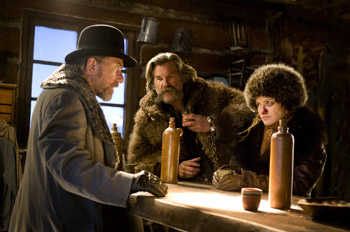 Jackson plays bounty hunter Major Marquis Warren, who is introduced standing over a pile corpses he intends to collect upon when he gets to Red Rock. 'Major Warren is an ex-cavalryman, an ex-slave. He joined the war to kill. He's still that guy. He's smarter than most people think. He's not a man of few words. He's a man of many words, but he only uses them when he needs to. He's pretty quick on the trigger. He'd rather kill you than talk to you," Jackson says of his character.
Jackson plays bounty hunter Major Marquis Warren, who is introduced standing over a pile corpses he intends to collect upon when he gets to Red Rock. 'Major Warren is an ex-cavalryman, an ex-slave. He joined the war to kill. He's still that guy. He's smarter than most people think. He's not a man of few words. He's a man of many words, but he only uses them when he needs to. He's pretty quick on the trigger. He'd rather kill you than talk to you," Jackson says of his character.
'You have eight people that are very different, that are very dangerous in their own way, and to varying degrees hateful. It's going to be a fun game for audiences to attach to a character," Jackson says.
Bob Richardson notes that there is an indelible connection between Tarantino and Jackson. 'Their interplay is remarkable because they are linked from a very early phase. Quentin has a deep respect for Sam, and Sam has an equal respect for Quentin. You have two of the best in the business. It's a remarkable relationship," Richardson notes.
Major Warren makes a deal to travel to Red Rock with John Ruth and Daisy Domergue, played by Kurt Russell and Jennifer Jason Leigh. Unlike Jackson's Warren, John 'The Hangman" Ruth brings his bounties in alive. Daisy, his bounty, is chained to him at all times. 'When John catches you, he makes sure you go to trial, and you're tried, convicted, and then you hang. He stays and watches to make sure you hang. He's someone who has become well-known for having a penchant for the law," Russell explains.
Thankfully, Russell and Leigh got along famously. 'There is no one in the world I would rather be chained to, I can say that quite honestly," Leigh says of the unique experience of playing off of Russell while attached at his hip. 'We joke about it being a marriage. It's the most dysfunctional marriage. It's -Who's Afraid of Virginia Woolf' in the Old West," Leigh jokes.
'She's pretty fearless, and she's a gutsy girl, and a little bit of an animal in her own way," Leigh notes of her character.
As luck would have it, Leigh was in the audience at the staged reading at the Ace. 'It was just so brilliant," Leigh recalls. 'We were excited to be there because it's something you never see. Quentin's writing is like no one else's, so it was a really thrilling night in the theater."
'Jennifer Jason Leigh is fearless," Sher says. 'She'll go anywhere, she'll try anything, she'll push it all the way, and as a result her character is constantly surprising throughout the entire journey."
Leigh comments on her character's place among the eight: 'Daisy is a gutsy girl, and she's a bit of an animal in her own way. But all of these people have their values, and they all have their soft spots."
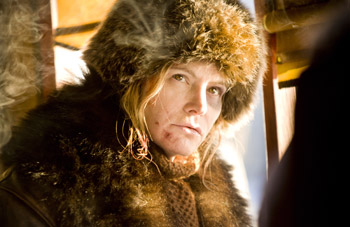 Tarantino made a small adjustment to his script just prior to production that required Leigh to play the guitar and sing a song. Leigh, who had not played guitar before, was a quick, determined student. When she was not filming, she devoted herself to practicing. 'I loved it," she recalls. 'There's something that really focuses you about learning a new instrument, and such a complex instrument, really."
Tarantino made a small adjustment to his script just prior to production that required Leigh to play the guitar and sing a song. Leigh, who had not played guitar before, was a quick, determined student. When she was not filming, she devoted herself to practicing. 'I loved it," she recalls. 'There's something that really focuses you about learning a new instrument, and such a complex instrument, really."
'I had a great guitar teacher, who was classically trained. That was helpful in terms of the finger picking, because there was a lot of finger picking," Leigh says. 'Quentin said, -I know you can do it.' He didn't worry about it for a second. That instills faith in you."
Through their travels, Warren, Ruth, Domergue cross paths with Chris Mannix, played by Walton Goggins. Goggins comments: 'When you distill it to the most simple version, Chris Mannix is a person hitching a ride on the road in the middle of a blizzard. He's a conduit for negativity. He's a perso
Jackson recalls Goggins's dedication to his role: 'Walt is fearless in what he does. He was the first person off-book. He came to the reading off-book."
'This story is about liars, and it's about lies. It's about people who want to get on with their lives, but can't. It's about claustrophobia, and it's a story about things that are never fulfilled," Goggins says.
Once the stagecoach arrives at Minnie's, the travelers meet a group of outsiders riding out the storm. Demian Bichir plays Bob, who Minnie leaves in charge of the Haberdashery while she is away. Bichir notes that everything takes a turn once the Eight are introduced: 'It's a big, wonderful reunion in hell, if we think that hell is this little cabin in the middle of a blizzard where nothing is what it seems."
'He can take one word and make it funny, and scary, and quotable, and memorable, because he brings so much of himself and his personal intelligence and magnetism," Sher says of Bichir.
As with Leigh and the guitar, Tarantino's screenplay called for Bichir to play the piano. 'The script says that Bob plays -Silent Night' with one finger. I thought, this should be easy. But then I learned how to play -Silent Night' in the classic way, and then I began playing with it."
Bichir recorded three different versions of 'Silent Night" and sent the options, each ranging in complexity and difficulty, to Tarantino. 'I thought he was going to come back to me and say, -I think you better play the flute or the ukulele or something," Bichir jokes. Instead, Tarantino responded to Bichir's elaborate arrangement. Bichir practiced tirelessly until his scene was filmed.
Michael Madsen, who plays 'cow puncher" Joe Gage, found that there are relatable elements to the conflicts that emerge among the eight. 'It's about society. It's about the psychological boundaries that people have with each other. It's about friendships and betrayals. It's a whole bunch of subjects with a cowboy hat on it," Madsen says.
Madsen enjoyed watching the action play out, even when he wasn't filming. 'Every character is so different from one another. It's wonderful to watch everyone find their character. I loved watching Tim Roth and Samuel L. Jackson especially. They were in a groove."
Tim Roth plays Oswaldo, Red Rock's British hangman. Roth welcomed the chance to speak Tarantino's dialogue again. 'Quentin writes unlike anybody. Bad dialogue is difficult to get your head around. It's hard to learn because you're reacting against it in your mind somewhere. This stuff goes in like silk. He tends to write with you in mind, but even if you stepped into someone else's role, it flows easily."
Bruce Dern plays confederate general Sanford Smithers. 'He's an honorarium to an era that doesn't exist anymore. He's beyond his time. He's trying to figure out what's going on in the remainder of his life. His wife is gone, the war is over, his son vanished. He's the most honest character in where he's coming from and where he's going," Dern notes.
The celebrated actor notes that the experience of being on a Tarantino film taught him a thing or two: 'I think he's the only director that now I could say, -I'm a graduate of the University of Tarantino,' because it is a complete education in filmmaking, and acting, and everything else."
James Parks, Zoë Bell, Lee Horsley, Dana Gourrier, Gene Jones, Keith Jefferson, Belinda Owino and Channing Tatum round out the cast.
Bell plays Six Horse Judy, whose name derives from her ability to commandeer a six-horse carriage. 'When I was reading it, because it's Quentin, I thought, -Oh he's going to want her actually doing it.' And that will be me having to learn it. I can honestly say it has been the most complicated skill I've had to acquire in my career."
'You not communicating with one other animal, but six of them. They don't speak human, and I -- not for lack of trying -- don't speak horse."
James Parks steers The Hateful Eight's other six-horse carriage. 'It's a skill that is not taught anymore, and certainly not taught to actors. It takes a long time to move from one horse to two, to four, and to six," Parks says.
'I pulled every string I could possibly pull to get in this movie," Channing Tatum says. 'I was willing to do anything, and I hadn't even read the script at that point."
As a fan of Tarantino's films, Tatum was honored to join a cast of Tarantino regulars. Tatum comments: 'It's pretty special. You're inducted into the Quentin Tarantino alumni, in a way. When I came to the first table people, I could feel a real camaraderie that only people who have worked with Quentin would have."
'Minnie is a spitfire," Dana Gourrier says of Minnie. 'She has no qualms about who she is, or about saying how she feels about anything. She's a cool lady. I think it should be noted that this takes place after the Civil War, and for a woman to be a property owner was a big deal. And she runs that haberdashery. It is her place. I found an excitement in that."
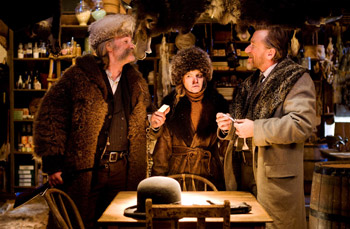 'You can't help but smile when you see her, because she's always smiling," Tatum says of Gourrier. 'As soon as you see her, immediately. I guess that's why Quentin cast her, because she feels like Minnie. She has a sweet heart in a hard world."
'You can't help but smile when you see her, because she's always smiling," Tatum says of Gourrier. 'As soon as you see her, immediately. I guess that's why Quentin cast her, because she feels like Minnie. She has a sweet heart in a hard world."
A mild winter threatened to hinder a production that called for a blizzard. The film's producers planned to shoot inside of Minnie's when the weather was good, and to shoot outside during snowfall. The snow took its time, but ultimately delivered.
The cast remained on call, in the event that the weather ever changed. Altitude and cold weather were a breeze compared to the psychological effects of waiting on Mother Nature. 'It wasn't so much the physical; we could deal with that," Roth recalls of the challenge of waiting for snow. 'It was the time that we weren't sure whether we were going to make it or not."
At the suggestion of some of Telluride's elected officials, the production participated in a ski burn, a town tradition that is meant to bring much-needed snow to the region. Many of the cast participated, along with locals and employees of nearby ski resorts. A huge snowstorm arrived just in time for the production to complete filming.
Following their time in Telluride, the production moved to Red Studios in Los Angeles. Refrigeration units made the stage replicate the air in Telluride. 'I thought I would miss the adversity that we faced in Colorado. Lo and behold, we get to Los Angeles and that goddamn stage is twenty-nine degrees," Goggins muses. It's colder here than it ever was in Colorado. That's how Quentin likes it. He wants people to feel it, and it isn't manufactured breath. He wants to see your breath."
As ambitious as Tarantino's western is, McIntosh found the experience to be a return to form for the director. 'I feel like he is going back to that first time he got to make a movie. He is so joyous, and so loving of what his actors are doing everyday with his dialogue. He's like the kid in the candy shop that can't get enough, and his enthusiasm is contagious."
The Hateful Eight
Release Date: January 21st, 2016
MORE
- Mission: Impossible Fallout
- Glenn Close The Wife
- Allison Chhorn Stanley's Mouth Interview
- Benicio Del Toro Sicario: Day of the Soldado
- Dame Judi Dench Tea With The Dames
- Sandra Bullock Ocean's 8
- Chris Pratt Jurassic World: Fallen Kingdom
- Claudia Sangiorgi Dalimore and Michelle Grace...
- Rachel McAdams Disobedience Interview
- Sebastián Lelio and Alessandro Nivola...
- Perri Cummings Trench Interview



